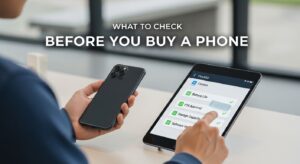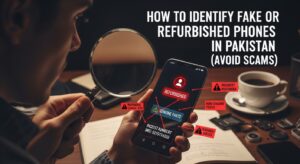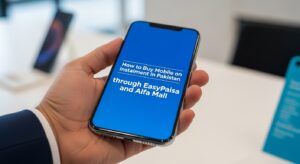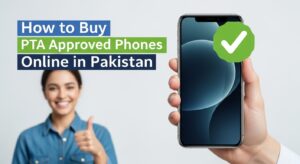Buying a new mobile phone in Pakistan can be an exciting experience, but it also comes with a crucial step you absolutely cannot skip: checking its Pakistan Telecommunication Authority (PTA) approval status. In recent years, the PTA, through its Device Identification, Registration, and Blocking System (DIRBS), has made it mandatory for all mobile devices operating on Pakistani networks to be properly registered and approved.
If a phone isn’t PTA-approved, it will eventually be blocked, rendering it useless on local cellular networks. This guide will walk you through every step to ensure your next phone purchase is compliant and trouble-free.
Don’t let the fear of a blocked phone ruin your investment. By understanding and following these simple checks, you can confidently buy any mobile device in Pakistan, whether it’s brand new, a used phone, or even one brought in from abroad.
Understanding PTA Approval: What It Means for Your Phone
Before diving into the “how-to,” let’s clarify what PTA approval actually signifies. Essentially, it means your mobile phone has been officially recognized and registered with the Pakistan Telecommunication Authority. This registration is critical because it ensures that the device is legally imported or brought into the country and has paid all applicable taxes and duties.
Why PTA Approval is Non-Negotiable
Ignoring PTA approval can lead to significant problems. Here’s why it’s so important:
- Avoiding Network Blocking: The most immediate consequence of a non-PTA approved phone is that it will eventually stop working on any Pakistani cellular network. You won’t be able to make calls, send SMS, or use mobile data.
- Ensuring Legality: Buying a PTA-approved phone means you’re acquiring a device that has followed all legal procedures for import and taxation. This protects you from potentially being linked to smuggled goods.
- Protecting Your Investment: A phone that doesn’t work on local networks is essentially a brick. Checking PTA approval before buying saves you from losing your hard-earned money on a device that won’t function as intended.
- Resale Value: A PTA-approved phone holds its resale value much better. No one wants to buy a phone that might get blocked, so a compliant device is always more attractive to potential buyers.
Step 1: Locate the Phone’s IMEI Number
The IMEI (International Mobile Equipment Identity) is a unique 15-digit number that acts like your phone’s fingerprint. Every mobile phone has at least one IMEI; dual SIM phones will have two, one for each SIM slot. This number is absolutely essential for checking PTA approval.
There are several reliable ways to find a phone’s IMEI:
- Dial *#06#: This is the simplest and most common method. Just open the phone’s dialer application and type *#06#. The IMEI number(s) will instantly appear on the screen. Jot it down carefully.
- Check Phone Settings: Navigate to the phone’s “Settings” menu. Look for “About Phone,” “System,” or a similar option. Within this section, you’ll usually find “Status,” “IMEI information,” or “Hardware Information” where the IMEI is listed. The exact path might vary slightly depending on the phone’s brand and Android version (e.g., for iPhones, go to Settings > General > About).
- Look on the Phone’s Box: If the phone comes in its original box, the IMEI number(s) is almost always printed on a sticker, usually on the side or back of the box. Compare this with the IMEI shown on the phone itself to ensure they match.
- Check Under the Battery (for older phones): For some older models with removable batteries, the IMEI might be printed on a sticker underneath the battery.
Pro Tip: If the phone has dual SIM slots, make sure to note both IMEI numbers, as both need to be registered for full functionality.
Common Mistake: Relying solely on the IMEI written on the box or a sticker. Always dial *#06# on the actual phone to confirm the IMEI. Sometimes, unscrupulous sellers might swap boxes or stickers.
Step 2: Utilize PTA’s Device Verification System (DIRBS)
Once you have the IMEI number, you can use PTA’s official Device Verification System (DIRBS) to check its approval status. There are primarily two convenient methods for this: via SMS or through the official online portal/app.
Method 1: SMS to 8484 (Easiest and Fastest)
This is arguably the quickest way to check PTA approval.
- Open your phone’s SMS app: Use any mobile phone with an active Pakistani SIM card.
- Create a new message: Type the 15-digit IMEI number (without any spaces, dashes, or special characters).
- Send it to 8484: This is the official PTA short code for device verification.
- Wait for the reply: You will receive an SMS reply within a few seconds.
The SMS reply will typically show one of the following statuses:
- “Device is Compliant” or “IMEI is Valid and Registered”: This means the phone is PTA-approved and legally imported/registered. You can proceed with confidence.
- “Device is Non-Compliant” or “IMEI is Valid but Not Registered”: This indicates the phone is not PTA-approved. It might have been brought into Pakistan without proper tax payment or registration. Such a phone will eventually be blocked.
- “IMEI is Invalid” or “IMEI is Blocked”: This is a red flag. An invalid IMEI could mean it’s a counterfeit or a tampered device. A blocked IMEI means the phone has been blacklisted, possibly due to being stolen or reported as non-compliant after a grace period. Avoid such devices at all costs.
Pro Tip: The SMS method is particularly useful when you’re inspecting a phone on the spot, for example, at a mobile shop or from an individual seller. Always perform this check before making any payment.
Common Mistake: Typing the IMEI incorrectly. Double-check all 15 digits before sending the SMS.
Method 2: Using the PTA/DIRBS Online Portal
For a more detailed check, or if you prefer using a computer, the online portal is an excellent option.
- Open your web browser: Go to the official PTA DIRBS portal. You can search for “PTA DIRBS” or “Device Verification System Pakistan” on Google to find the correct link. Ensure it’s an official government website (usually ending in .gov.pk).
- Enter the IMEI: On the portal, you will find a designated field to enter the 15-digit IMEI number.
- Complete the reCAPTCHA: This is usually a simple “I’m not a robot” check.
- Click “Check” or “Submit”: The system will process your request and display the device status on the screen.
The online portal provides similar status messages to the SMS service, often with a bit more detail. It will clearly state if the device is compliant, non-compliant, or blocked.
Pro Tip: Some websites might try to impersonate the official PTA portal. Always verify that the URL is legitimate to avoid scams or misinformation.
Method 3: Using the PTA DVS Mobile App
The Pakistan Telecommunication Authority (PTA) also offers a dedicated “Device Verification System (DVS)” mobile application, available for both Android and iOS devices.
- Download the app: Search for “PTA DVS” on your device’s app store (Google Play Store for Android, Apple App Store for iOS). Ensure you download the official app published by “Pakistan Telecommunication Authority.”
- Open the app: Once installed, launch the application.
- Enter or Scan IMEI: The app will have a field to enter the IMEI manually. Some versions might also offer a camera-based scanner to read the IMEI from a sticker or box, which can be very convenient.
- Check status: Tap the “Check” or “Verify” button. The app will display the device’s PTA approval status.
This app provides a user-friendly interface and can be very useful for frequent buyers or those who prefer mobile applications.
Pro Tip: Keep the app updated to ensure you’re using the latest version with any bug fixes or new features.
Step 3: Interpreting the PTA Approval Status
Understanding what each status means is crucial for making an informed decision about your phone purchase.
“Compliant” or “Registered”
This is the ideal status. It signifies that the mobile device has been properly registered with PTA and all applicable taxes/duties have been paid. This phone is legal to use on all Pakistani networks.
“Non-Compliant” or “Not Registered”
This status indicates that the phone’s IMEI is valid but it has not been registered with PTA. This often happens with phones brought into Pakistan by individuals (e.g., from abroad) who haven’t paid the required PTA tax within the grace period (usually 60 days for personal imports). Such devices will eventually be blocked by local networks.
Avoid buying such a phone unless you are prepared to pay the PTA tax yourself to get it registered. The tax amount can be substantial, sometimes even exceeding the phone’s value. If a seller insists the tax can be paid later, understand that it will be your responsibility and cost.
Common Question: “Can I just use it with Wi-Fi?” Yes, a non-compliant phone might still work on Wi-Fi for internet Browse or app usage, but its primary function as a cellular phone will be lost.
“Blocked” or “Invalid IMEI”
This is the worst-case scenario. “Blocked” means the phone has already been blacklisted by PTA and will not work on any Pakistani network. “Invalid IMEI” suggests the IMEI is not legitimate, which could mean the phone is a counterfeit or has had its IMEI tampered with. These are often “patched” phones where the IMEI has been illegally changed.
Absolutely do NOT buy a phone with either of these statuses. It is completely useless for cellular connectivity in Pakistan, and possessing or selling devices with invalid/tampered IMEIs can have legal repercussions.
Pro Tip: Some sellers might try to sell “non-PTA” or “patched” phones at significantly lower prices. While tempting, these are extremely risky purchases. The PTA regularly cracks down on such devices, and you risk losing your entire investment.
Step 4: Additional Considerations and Tips
Beyond the basic PTA approval check, there are a few other things you should keep in mind to ensure a smooth purchase experience.
For Imported Phones (from overseas Pakistanis or travelers)
If you’re buying a phone that someone brought from abroad, understand the rules:
- Grace Period: Individuals are allowed to bring one mobile phone per passport into Pakistan duty-free for personal use. However, it must be registered within a certain grace period (typically 60 days) to avoid being blocked.
- Temporary Registration: Overseas Pakistanis and foreign nationals visiting Pakistan can avail a temporary mobile registration facility for up to 120 days per visit. This is free of charge and ensures uninterrupted mobile connectivity during their short stay. Do not mistake this for permanent PTA approval for sale.
- PTA Tax Payment: After the grace period, if the phone is not registered, its owner will need to pay PTA taxes to get it approved. The tax amount depends on the phone’s value and model. You can check the estimated tax on the FBR (Federal Board of Revenue) website or through various online calculators.
Pro Tip: If you’re buying an imported phone, confirm with the seller that they have either already paid the tax or that the phone is within its grace period and you understand the tax implications.
Verifying the Seller
While the PTA check verifies the device, it’s also important to verify the seller, especially for used phones or non-retail purchases.
- Reputable Dealers: Always try to buy from established mobile stores or reputable online marketplaces. They are more likely to sell PTA-approved devices and offer some form of guarantee.
- Private Sellers: If buying from an individual, insist on performing the PTA check yourself in front of them. Ask for the original box and any purchase receipts.
- Be Wary of “Bargains”: If a deal seems too good to be true, it probably is. Unusually low prices often indicate a non-PTA approved, stolen, or damaged device.
Testing the Phone Thoroughly
Even if a phone is PTA-approved, it’s wise to test its basic functionalities before finalizing the purchase:
- Insert a SIM Card: Put your own active SIM card into the phone to confirm it catches network signals, makes calls, and uses mobile data. This also double-checks the PTA approval in real-time.
- Check Wi-Fi and Bluetooth: Ensure these connectivity options work.
- Test Camera, Speakers, Microphone: Make a quick call, record a video, and play some music to check audio and visual components.
- Screen and Buttons: Inspect for any cracks, dead pixels, or unresponsive areas on the screen. Test all physical buttons.
- Charging Port: Plug in a charger to ensure it charges properly.
Pro Tip: Don’t feel rushed by the seller. Take your time to perform all necessary checks and tests.
Conclusion
Checking PTA approval before buying a mobile phone in Pakistan is not just a recommendation; it’s a critical step to protect yourself from significant financial loss and potential legal issues. By simply finding the phone’s IMEI number and using the official PTA SMS service (8484), online portal, or mobile app, you can instantly determine its legality and functional status on Pakistani networks.
Remember, a little vigilance goes a long way. Always prioritize PTA-approved devices to enjoy seamless mobile connectivity and peace of mind with your purchase. Happy phone hunting!
Resources
- PTA Official Website (for DIRBS portal and information)
- FBR (Federal Board of Revenue) Website (for mobile tax details and payment)
- PTA DVS (Device Verification System) App (available on Google Play Store and Apple App Store)










